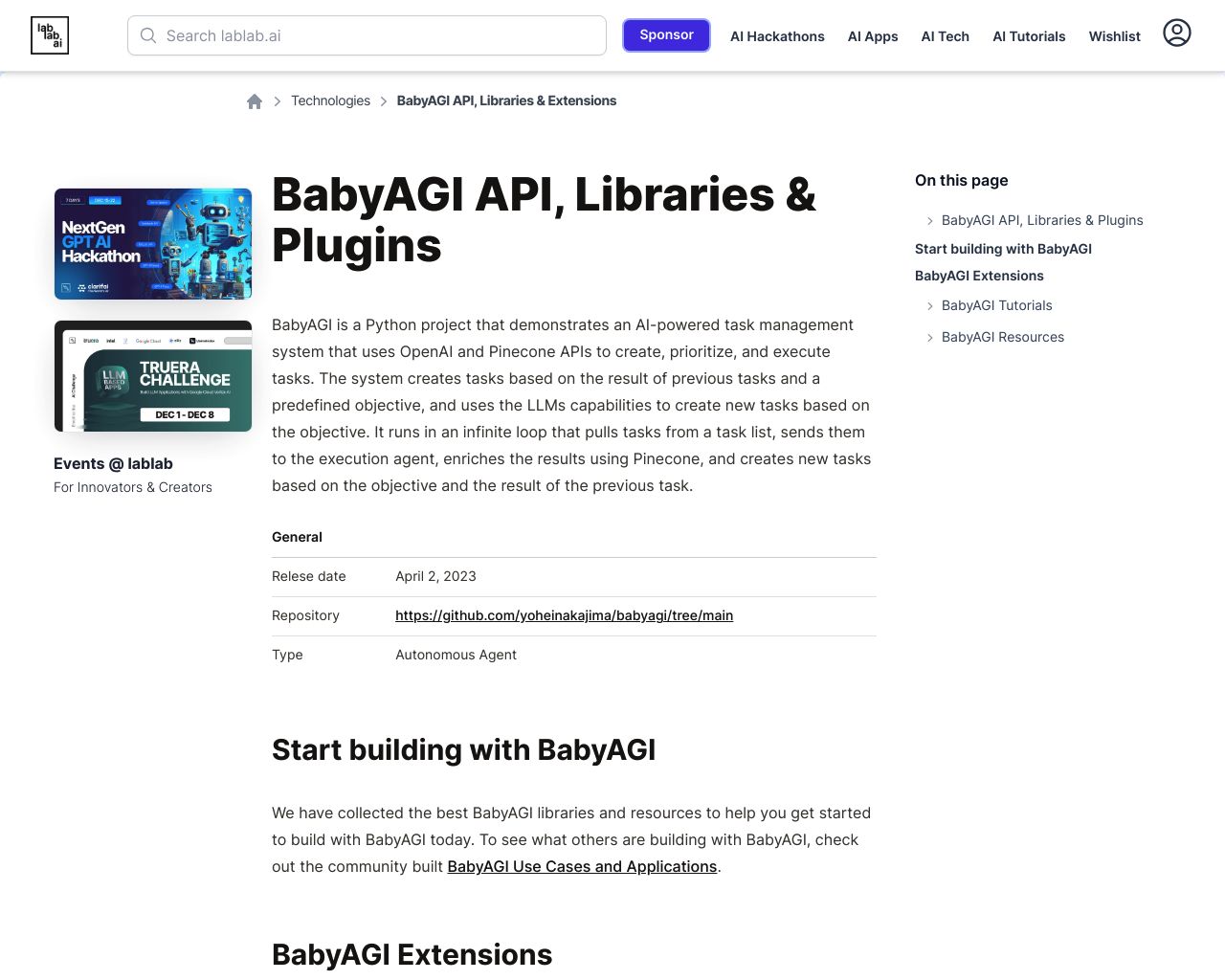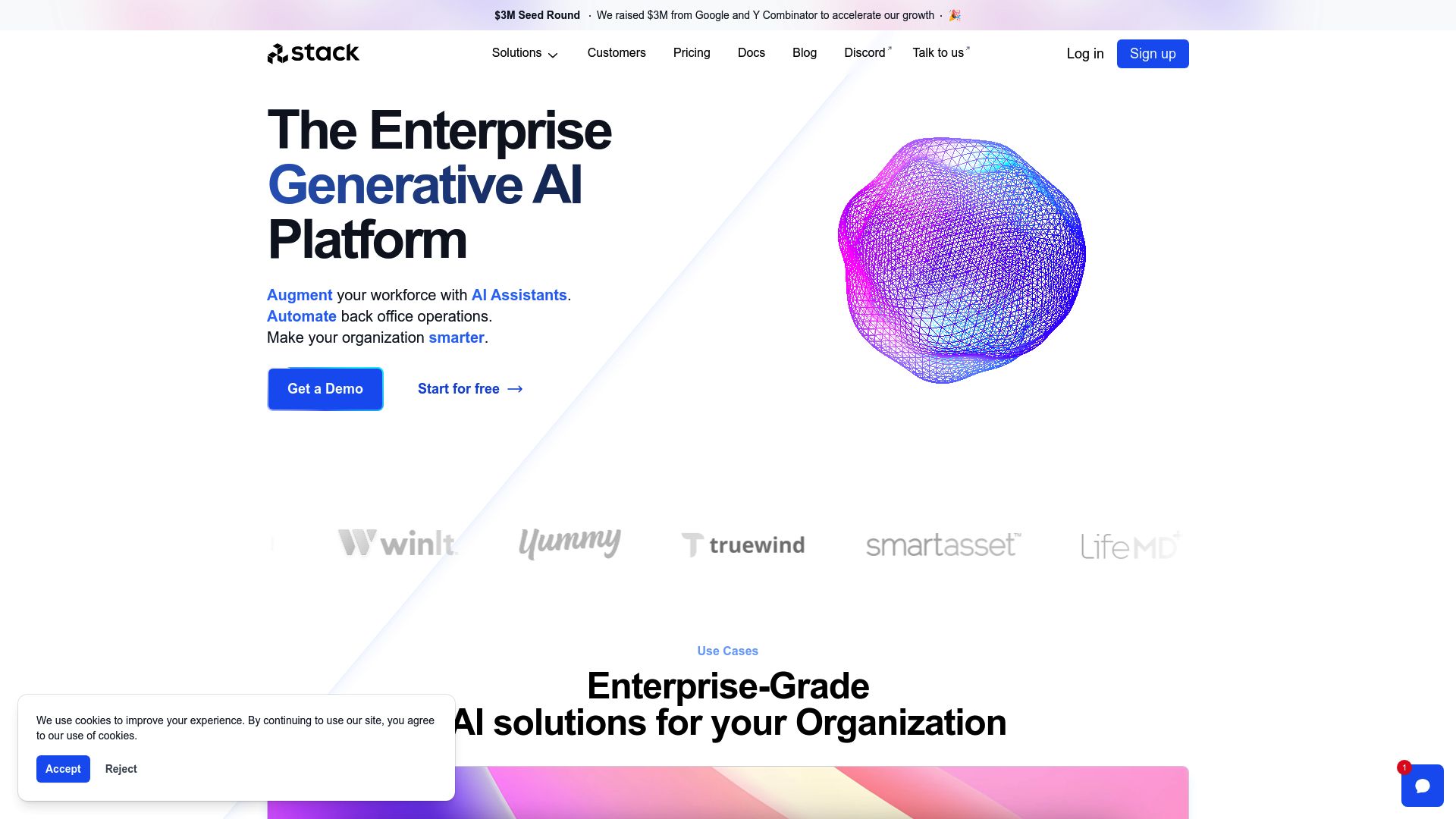BabyAGI vs. Stack AI: Comparing Autonomous and Low-Code AI Platforms
AI agent development platforms are transforming how businesses harness artificial intelligence. BabyAGI vs. Stack AI offer distinct approaches, each with unique strengths and limitations. BabyAGI excels in autonomous task management and problem-solving, while Stack AI prioritizes accessibility through a low-code interface.
This comparison explores their key features, use cases, and potential drawbacks. We’ll also introduce SmythOS, a comprehensive solution that combines the best of both platforms while addressing their shortcomings. Whether you’re a developer seeking advanced AI capabilities, a business leader looking for scalable solutions, or a non-technical professional exploring AI automation, this analysis will help you navigate the landscape of AI agent builders and choose the right tool for your needs.
BabyAGI Overview
BabyAGI represents an innovative open-source project in artificial intelligence, designed to simulate human-like cognitive processes for task management. This autonomous AI agent generates, prioritizes, and executes tasks based on predefined objectives, continuously learning and adapting to new challenges.


Developed by Yohei Nakajima, BabyAGI leverages advanced natural language processing capabilities from OpenAI and vector databases like Pinecone to store and retrieve task results. This integration enables the system to maintain context and learn from past experiences, mimicking human cognitive processes.
BabyAGI leverages advanced natural language processing capabilities from OpenAI and vector databases like Pinecone to store and retrieve task results.
BabyAGI excels in problem-solving by breaking down complex objectives into manageable tasks. Its iterative approach allows it to tackle challenges across various fields, from customer service to healthcare. For instance, in education, BabyAGI could analyze student performance data and suggest personalized learning plans.
While BabyAGI offers powerful autonomous capabilities, it has limitations. The platform lacks a visual builder or no-code editor, requiring users to have Python programming skills. It also doesn’t provide specific features for multi-agent collaboration, human-AI interaction, or deployment options like API or webhook integrations. These constraints may limit its accessibility for non-technical users or those seeking ready-to-deploy solutions.
Despite these limitations, BabyAGI’s open-source nature and focus on task-driven autonomy make it a valuable tool for developers and researchers pushing the boundaries of artificial general intelligence. Its ability to continuously learn and improve positions it as a significant player in the ongoing development of more flexible and adaptable AI systems.
Stack AI Overview
Stack AI empowers organizations to harness generative AI without extensive coding expertise. This low-code platform enables the creation of AI-powered workflows and custom AI assistants, democratizing access to advanced AI capabilities across industries.


Stack AI’s platform features a user-friendly drag-and-drop interface, making AI development accessible to non-programmers. The system supports extensive integrations with popular services like Google Drive, Salesforce, and Slack, allowing seamless incorporation of AI into existing workflows. Enterprise-grade security measures, including SOC 2, HIPAA, and GDPR compliance, ensure data protection and privacy.
Stack AI’s platform features a user-friendly drag-and-drop interface, making AI development accessible to non-programmers.
Users can leverage Stack AI to build AI assistants for various applications, from physician co-pilots generating SOAP reports to investment memo generators. The platform includes pre-built templates for common use cases, accelerating development time. Customizable deployments allow flexibility in implementation, whether through tailored user interfaces or API endpoints.
While Stack AI offers powerful capabilities, it may not fully meet the needs of advanced developers seeking granular control over AI models. The platform’s focus on accessibility could potentially limit fine-tuning options for highly specialized applications. Additionally, as with many cloud-based solutions, users should consider data residency requirements and potential latency issues when deploying Stack AI in sensitive or time-critical environments.
Stack AI positions itself as a versatile solution in the competitive AI landscape. Its strengths lie in rapid development, ease of use, and broad applicability across industries. However, organizations with complex, proprietary AI requirements may find the platform’s abstraction layer limiting. As AI technologies evolve, Stack AI’s ability to incorporate cutting-edge advancements while maintaining its user-friendly approach will be crucial for long-term success.
Feature Comparison
BabyAGI and Stack AI take different approaches to AI agent development, with distinct strengths and limitations. BabyAGI excels in autonomous task management and problem-solving, leveraging advanced natural language processing to generate, prioritize, and execute tasks independently. Its integration with vector databases like Pinecone enables effective memory and context handling, allowing the system to learn from past experiences.
Stack AI, on the other hand, focuses on accessibility and ease of use with its low-code platform and drag-and-drop interface. This approach democratizes AI development, making it possible for users without extensive coding expertise to create AI-powered workflows and custom assistants. Stack AI’s strength lies in its extensive integrations with popular services and pre-built templates for common use cases, accelerating development time for businesses across various industries.
However, both platforms have notable feature gaps. BabyAGI lacks a visual builder or no-code editor, requiring users to have Python programming skills. It also doesn’t offer specific features for multi-agent collaboration or human-AI interaction. Stack AI, while more user-friendly, may not provide the same level of autonomy and problem-solving capabilities as BabyAGI, potentially limiting its effectiveness for complex, specialized AI applications.
In contrast, SmythOS bridges these gaps by offering a comprehensive platform that combines the strengths of both approaches. We provide a visual drag-and-drop interface for easy agent creation, support for autonomous agents with advanced problem-solving capabilities, and extensive integration options. Our platform also excels in areas where both BabyAGI and Stack AI fall short, such as offering debug tools, multi-agent collaboration features, and flexible deployment options including API, webhook, and scheduled agent functionalities.
Feature Comparison Table
| BabyAGI | Stack AI | SmythOS | |
|---|---|---|---|
| CORE FEATURES | |||
| Hosted Agents (Dev, Production) | ❌ | ✅ | ✅ |
| Environments (Dev, Production) | ❌ | ✅ | ✅ |
| Visual Builder | ❌ | ✅ | ✅ |
| No-Code Options | ❌ | ✅ | ✅ |
| Explainability & Transparency | ❌ | ✅ | ✅ |
| Human-AI Interaction | ❌ | ✅ | ✅ |
| Audit Logs for Analytics | ❌ | ✅ | ✅ |
| Agent Work Scheduler | ❌ | ✅ | ✅ |
| Logs & Monitoring | ❌ | ✅ | ✅ |
| SECURITY | |||
| Constrained Alignment | ❌ | ❌ | ✅ |
| IP Control | ❌ | ❌ | ✅ |
| COMPONENTS | |||
| Foundation AIs | ❌ | ✅ | ✅ |
| Huggingface AIs | ✅ | ❌ | ✅ |
| Data Lakes | ❌ | ✅ | ✅ |
| DEPLOYMENT OPTIONS (EMBODIMENTS) | |||
| Staging Domains | ❌ | ✅ | ✅ |
| Production Domains | ❌ | ✅ | ✅ |
| Deploy as Scheduled Agent | ❌ | ❌ | ✅ |
| DATA LAKE SUPPORT | |||
| Sitemap Crawler | ❌ | ❌ | ✅ |
| YouTube Transcript Crawler | ❌ | ❌ | ✅ |
Best Alternative to BabyAGI and Stack AI
SmythOS stands out as the superior alternative to BabyAGI and Stack AI, offering a comprehensive platform that combines powerful AI capabilities with unparalleled ease of use. Our drag-and-drop interface eliminates the need for extensive coding knowledge, making advanced AI development accessible to users of all skill levels. Unlike BabyAGI’s limited autonomy and Stack AI’s constraints on complex applications, SmythOS enables the creation of truly autonomous agents capable of tackling intricate, specialized tasks across industries.
SmythOS stands out as the superior alternative to BabyAGI and Stack AI, offering a comprehensive platform that combines powerful AI capabilities with unparalleled ease of use.
We pride ourselves on our extensive feature set, which surpasses both BabyAGI and Stack AI. SmythOS supports multi-agent collaboration, allowing AI agents to work together seamlessly on complex projects. Our platform also excels in human-AI interaction, facilitating natural and efficient communication between users and AI assistants. These capabilities, absent in BabyAGI and limited in Stack AI, open up a world of possibilities for businesses and developers alike.
SmythOS’s versatility shines through its unlimited use cases. From automating customer service operations to optimizing supply chain management, our platform adapts to diverse business needs. We offer pre-built templates and integrations with popular services, accelerating development time without sacrificing customization options. This flexibility, combined with our robust API support, allows for seamless integration into existing workflows—a critical advantage over both BabyAGI and Stack AI.
SmythOS’s versatility shines through its unlimited use cases. From automating customer service operations to optimizing supply chain management, our platform adapts to diverse business needs.
Security and scalability are paramount in SmythOS. We implement advanced features like constrained alignment and IP control, ensuring that AI agents operate within defined parameters and adhere to organizational policies. Our platform scales effortlessly to meet growing demands, supporting enterprise-level deployments without compromising performance. These critical aspects, often overlooked or underdeveloped in BabyAGI and Stack AI, make SmythOS the ideal choice for businesses of all sizes looking to harness the full potential of AI technology.
By choosing SmythOS, users gain access to a cutting-edge AI platform that not only bridges the gaps left by BabyAGI and Stack AI but also pushes the boundaries of what’s possible in AI automation. Our commitment to innovation, ease of use, and comprehensive support empowers organizations to transform their operations, drive efficiency, and unlock new opportunities in the rapidly evolving landscape of artificial intelligence.
Conclusion
BabyAGI and Stack AI offer unique approaches to AI development, each with distinct strengths. BabyAGI excels in autonomous task management and problem-solving, while Stack AI focuses on accessibility with its low-code platform. However, both have limitations that may restrict their usefulness for certain users or applications.
SmythOS emerges as a comprehensive solution that combines the best aspects of both platforms while addressing their shortcomings. We offer a visual drag-and-drop interface for easy agent creation, support for autonomous agents with advanced problem-solving capabilities, and extensive integration options. Our platform also provides features lacking in both BabyAGI and Stack AI, such as debug tools, multi-agent collaboration, and flexible deployment options including API, webhook, and scheduled agent functionalities.
For organizations seeking a versatile, powerful, and user-friendly AI development platform, SmythOS stands out as the superior choice. Our solution caters to a wide range of users, from developers and technical teams to business leaders and non-technical professionals. With SmythOS, you can harness the full potential of AI to transform your workflows, automate complex tasks, and drive innovation across your organization.
To experience the future of AI development and deployment, explore our diverse range of AI-powered agent templates or create a free SmythOS account today. Discover how SmythOS can revolutionize your approach to AI and unlock new possibilities for your business.
Last updated:
Disclaimer: The information presented in this article is for general informational purposes only and is provided as is. While we strive to keep the content up-to-date and accurate, we make no representations or warranties of any kind, express or implied, about the completeness, accuracy, reliability, suitability, or availability of the information contained in this article.
Any reliance you place on such information is strictly at your own risk. We reserve the right to make additions, deletions, or modifications to the contents of this article at any time without prior notice.
In no event will we be liable for any loss or damage including without limitation, indirect or consequential loss or damage, or any loss or damage whatsoever arising from loss of data, profits, or any other loss not specified herein arising out of, or in connection with, the use of this article.
Despite our best efforts, this article may contain oversights, errors, or omissions. If you notice any inaccuracies or have concerns about the content, please report them through our content feedback form. Your input helps us maintain the quality and reliability of our information.
